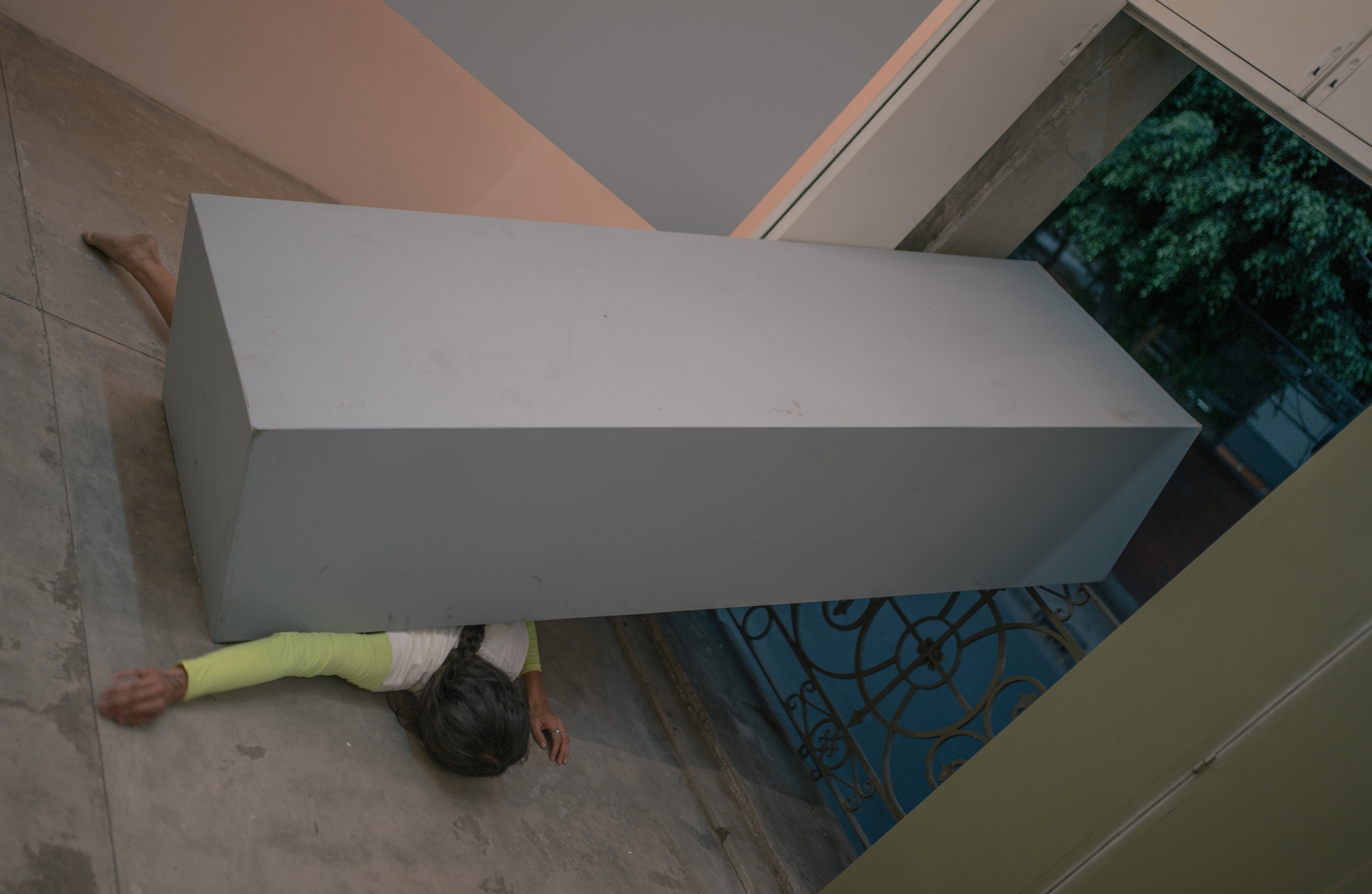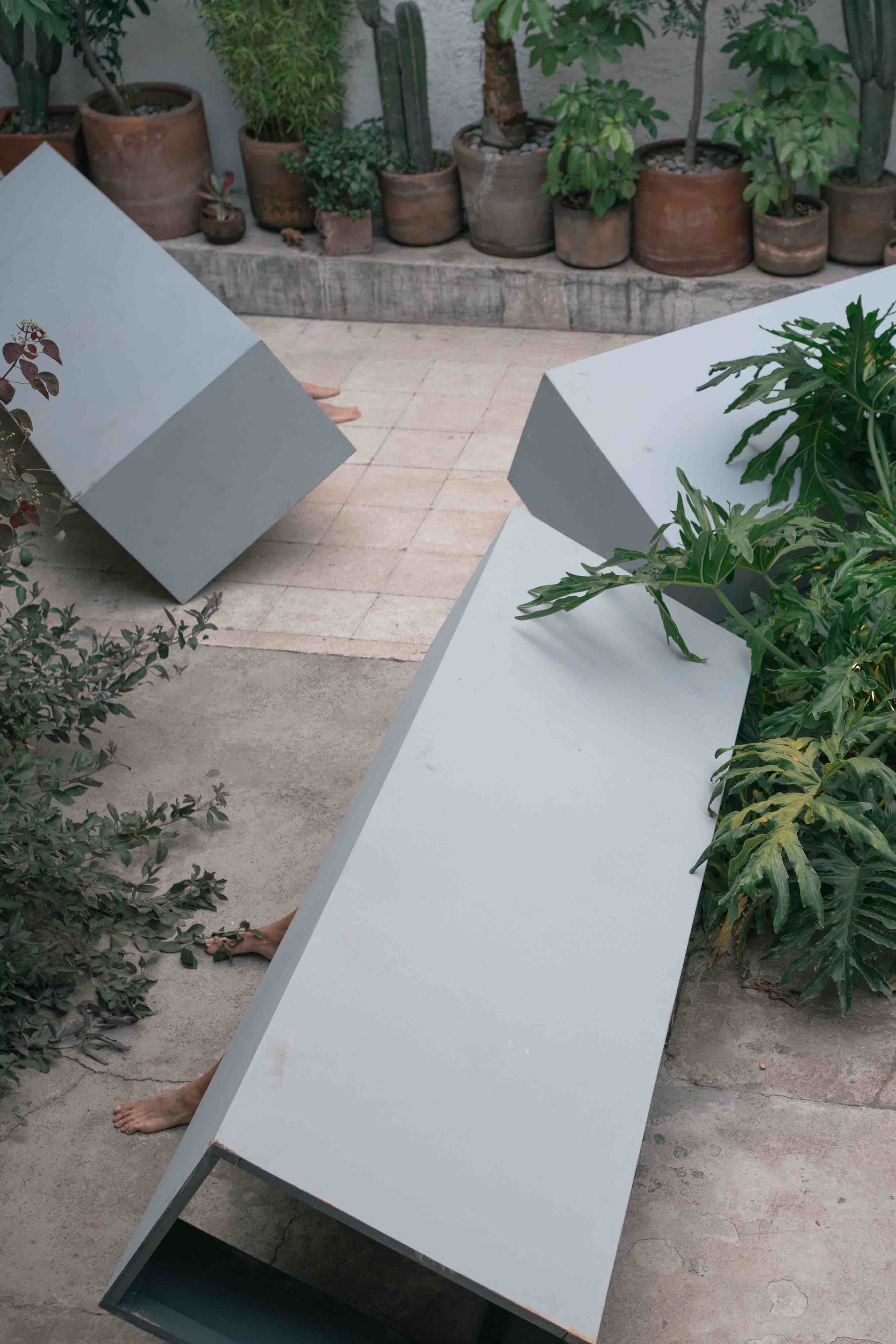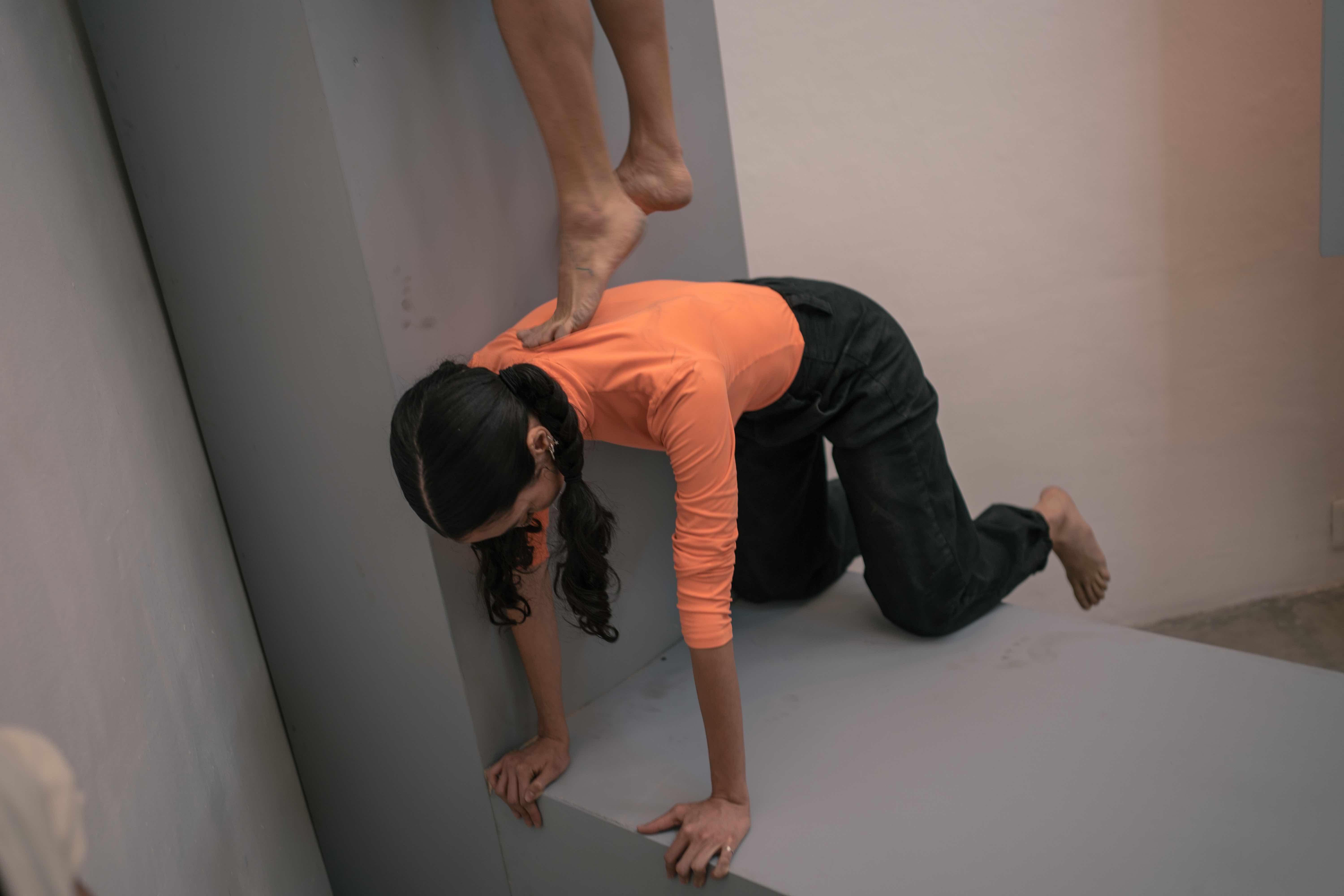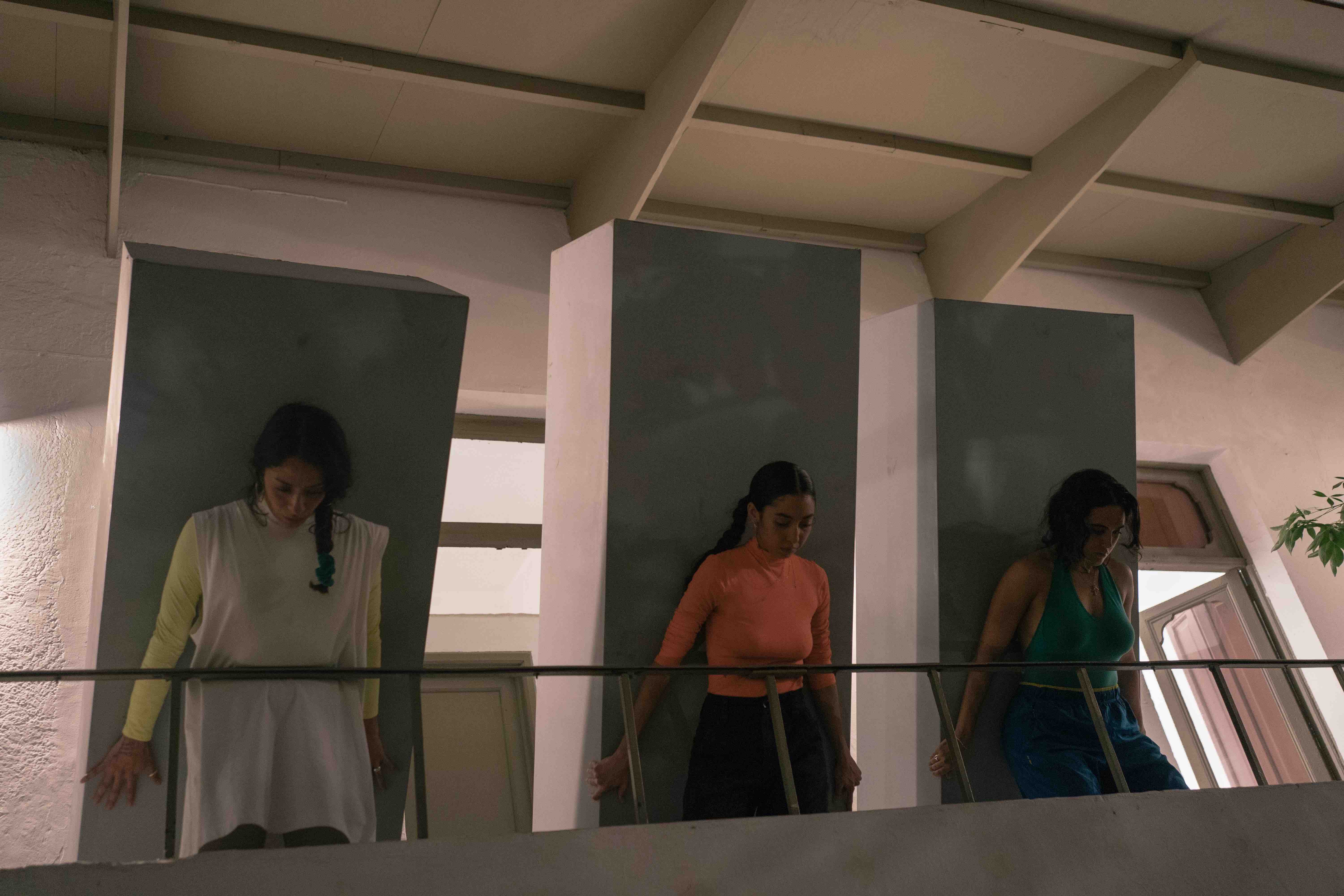
Review
The Rhythm of Carrying: Investigations into Space and Body
by Regina Diaz
Pieza III at Vernacular
Reading time
6 min
Camila Arroyo, Renata Pereira Lima, and Ana G. Zambrano form, at times, Pieza III, a triad that puts into question, both individually and collectively, what choreography is, as well as what are its frontiers and possibilities. “Everything’s been a haphazard and fortuitous act”—albeit not without intention, says Ana. Rather, the process resembles a tarot reading: desires and questions are present in their endless possibilities, even if what’s needed is a proclamation in space and time.
The investigations making up Pieza III began in 2019, during the exhibition Sobre las Convenciones del Dibujo (“On the Conventions of Drawing”) by Andrés Hessinger, with interventions into a series of the artist’s sculptures. Nevertheless, the members have distanced themselves from that first encounter: at the same time that the ties between them have acquired new meanings, the characteristics of the sculptures have changed. The different experiences of process as well as the specific architectures of each presentation space help to provoke variations in the characteristics of the sculptures with which they create their choreography. They now pursue their explorations using three gray boxes, much narrower and significantly heavier than in previous versions. The dragging, damage, and wear endured by both bodies and sculptures have led to new forms.
Vernacular Institute, founded in 2014, has hosted the project by Alia Farid, At the time of Ebb, and also recently inaugurated Songs We Carry by Taiwanese artist Charwei Tsai, in collaboration with Tibetan filmmaker Tsering Tashi Gyalthang. During Mexico City’s art week Jo Ying Peng, an independent curator affiliated with the space, invited the triad to proclaim themselves in a new space.

The piece begins on the ground floor of a house with olive green doors and windows, in Santa María de la Ribera. There’s still daylight; three gray wooden figures are spread out in a small courtyard lined with plants. The visitors nestle themselves where they can: on the floor, on the stairs, and on the second-floor balcony. Suddenly, without much fuss, the artists appear in the space and enter the three sculptures that, for the moment, remain inert. Locked in the darkness of the interior and cut off from the conversations of those visitors surrounding them, their notion of time is undone. I would say that we all feel a certain anxiety upon imagining such a restricted space; for a moment the boxes look like coffins with living bodies inside.
Given art week’s effervescence, the triad had to impose silence on everyone. By making the pieces resonate, they reminded us of their presence, communicated with each other, and began orchestrating the encounter. The sound gave way to the movement and the body responded by making noise. Tired arms let go of the sculptures, which hit the floor, rumbling. The weight they carry on their legs translates into murmurs between each step; the gentle impact between palm of the hand and wood becomes a kind of pacemaker.
In their transit, the triad manipulates the boxes, their bodies, and the audience. Pieza III consists of an anthropometric investigation—of the body—that delves into expanded choreography from a specific context. That is, the choreography is filtered by encouraging and challenging the three loads, the space, as well as everyone present. They go up, they go down, they stagger, and they merge the boxes with their skin and the architecture of the house. With the help of the floor, the railings, and the walls, they generate a rhythm by scraping and striking the material. The rhythm facilitates a dialogue between the visitors, the space, and themselves. The course of the night revealed our interdependence: the audience, the plants, and Scorpio—Jo Ying Peng’s cat—also carried out choreography, gestating movements that formulated spaces for the triad’s passage.

Playing with these columns is a wink toward a challenge that, as simple as it may seem, takes a tremendous effort. The choreography movements are slow and heavy: there’s awareness of every step. This act invites one to ask: “What if the wear and tear could speak? What if the bruises and scrapes could be publicly recognized?” Perhaps, if these could speak, or if we listened, choreographic investigations would be more greatly valued and we would build a juster infrastructure.
For the evening, they designed an ephemeral labyrinth that began in the darkness of the rectangles’ interiors and continued by occupying the different nooks of the institute. Encounters like this explore the potential of sound, play, and bodies: these upheavals also break the static and sterile legacy of minimalist sculpture by altering the dynamic around the sculptures. In Pieza III, the body imposes itself on the structure and causes a confrontation; in the choreography one can observe both risk and trust in the shared steps that iterate sporadically between submission, resistance, and collaboration.

The structures are cargos as well as shelters. Squeezed into one of the rooms on the second floor, we observe how the triad creates a vertiginous pause during which they enter, one by one, the darkness of the very same box. Thus, stealthily and carefully, the cargo is transformed into a bunker whose strength depends on the harmony between their bodies. They demonstrate to us the capacity for both assimilation and transmutation between body and structure. They mold vulnerable spaces, distribute their weight, and, using their bodies, contain the risks.
In retrospect, thinking about the structures we inhabit every day—houses, forms of transportation, public spaces, and more—Pieza III explores what it is to recognize both concrete and greenness as prostheses of our individual and collective bodies, or, conversely, ourselves as prostheses of the same. Clearly this recognition is not simple. From one moment to another we would be much heavier, but it’s not a matter of simplifying, polishing, or winning. It’s rather a matter of facing situations to which we submit ourselves by making decisions in common. To choose narrower and heavier boxes insofar as we find support among us. To carry them up the stairs dragging our already dusty feet and, also, to let go of them when our body can no longer hold them. To find the strength to lift them up again by observing that the other is already carrying it on her back. It’s about inhabiting resistance.
— Regina Diaz
Translated to English by Byron Davies

Camila Arroyo is a choreographer, performer, and movement director. Her work seeks to expand conceptions of choreography based on corporal, theoretical, and video investigations, which are always crossed by a communal, collaborative, and interdisciplinary lens. www.camila-arroyo.com
Renata Pereira Lima is a Cuban-Brazilian choreographer whose practice explores the body as an archivable container of reactionary phenomena, via dance performances and gestures, in situ investigations, performance, and video-making. www.renatapereiralima.com
Ana G. Zambrano develops her practice in the field of living art as a choreographer, dancer, and teacher, within which improvisation is the line of transversal of an expanded investigation. She explores such media as performance, video, and education, thinking of them as friendly territories for the hybridization of languages.
Published on May 22 2021